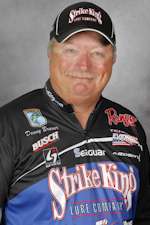Over the last six lessons we've talked about tackle and equipment as well as some of the basics of presentation. All of that is for naught, however, if you don't pick the right mat and fish it correctly.
First, let me say that as a general principal you should look for windy mats when conditions are positive. Bass relate to current — probably because current positions the baitfish — when things are going their way. Mats make excellent ambush points.
On the other hand, when conditions are negative I like to look for mats in more protected areas. It's been my experience that bass move into protected areas when things are not going their way. Mats are some of their favorite overhead cover.
If you're fortunate enough to be fishing when things are positive and there's a little wind, remember that wind makes current. Fish the current under the mat just like you would a stump in a river. There's no difference. Before you ever make a cast look for the ambush point. Where would you hide?
Think of the mat as a funnel forcing the water to move in a certain direction. As you follow the current with your eyes, think about the bass. Where does he or she want to hide to create the best chance of a meal? (You'll be surprised at how good you can get at this with a little practice.)
Once you've made those decisions, your best presentation point should be obvious. It should also be your first one. Don't waste time tossing your lure into unlikely places unless you're forced to do so. Go for the best first with everything you've got.
Regardless of the conditions, however, never forget that you're fishing vegetation. You should always be looking for something different, something out of the ordinary that doesn't belong. A piece of wood is obvious. Equally obvious to the fish is a change in the type of vegetation. If the mat is primarily one type of weed, look for a spot that's made from another type. That's your target.
And never pass over a horizontal and vertical intersection. What I mean by this is that the mat is horizontal. It lays on the water's surface. A reed, lily pad or stump is vertical. It runs from the bottom up toward the top. The point at which these two spots intersect is as close to a guaranteed fish as you'll ever get in this business. It's the hottest hot spot I know about.
Another thing you need to keep in mind when you're fishing mats is that the strike zone can be very small. Sometimes one or two inches off the mark can make a huge difference. It's essential that you put your bait exactly where it needs to be. Learn to be precise with your flips and your pitches. If you need to practice, get with it. Don't wait until you're on the water.
Accurate flipping and pitching allows you to properly fish a mat quickly and efficiently. You won't have to make several presentations to hit your target. That means you can fish more mats in a day, which means you'll catch more bass. It's simple math as far as I'm concerned.
I would also suggest that when you catch a bass under a mat you continue fishing it for a few minutes. Don't assume there's only one there. You can often catch several from one small spot on small mat.
Finally, always think after you catch a bass. Try to determine why it was there and what made it bite. Where was the current; what about the vegetation; was there a horizontal and vertical intersection; where was the sun; and, did water depth or bottom composition play a role in your success? The faster you figure everything out, the more bass you'll catch.





